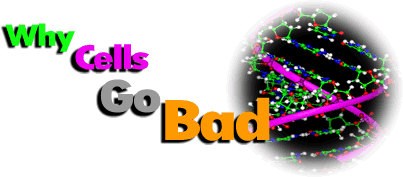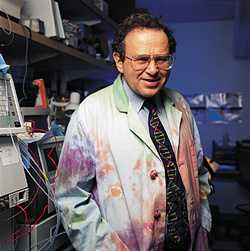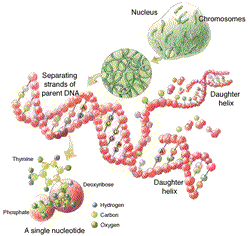
Part Two: Don't Kill Cancer, Just Slow it Down
His essay outlined a theory that he called "the mutator phenotype hypothesis." Mutation, the altering of the genes of an organism, can happen in hundreds of ways, from direct physical damage to the cell, to an enzyme that misbehaves during the copying process.
Imagine your DNA as a book ready for publication. Problems in publication could range from the big—a freeway crash of the truck carrying the original manuscript—to the small—a single typographical error entered by the finger of a sleepy typesetter. Big or small, any difference between original and copy is a mutation.

UW Professor Lawrence Loeb in a tie-dyed lab coat given to him by his daughter. Photo by Mary Levin.
Imagine this book tells the story of the life of a cell. It outlines every chemical reaction that needs to happen for that cell to work properly. It explains how the cell should use fuel, consume oxygen, protect itself from invaders, and replicate itself when the time comes for a new cell. If an error in the book says to make the wrong protein, even wrong by a single small part, that protein will not work properly in a sequence of chemical reactions that might be 100 changes long.
What Loeb proposed, but could not prove at the time, is that cancer cells arise when the machinery that maintains the integrity of copying DNA is thrown off. An entirely new kind of cell, possessing what he calls "a mutator phenotype," is born.
A mutator phenotype may result from different events, but one example is faulty copying machinery. Imagine our DNA publication rolling to a proofreading department in the cell. Enzymes known as polymerases are often involved in this proofreading. Now, what if something has happened to make all the proofreaders blind? All the mistakes will get left in this copy. These mistakes cause even more mistakes. Even if our proofreaders regained their sight, they couldn't catch all of them.
The human body can throw up quite a few barriers to cancer cell growth in the early going. But each new mistake or mutation may prove invulnerable to one of those barriers, and thus, allow some of the cancer cells to survive. This ability to overcome every weapon is a hallmark of aggressive cancer.

This sketch, from the US Department of Energy's Human Genome Program, shows basic DNA location and replication information.
Recent laboratory studies, the likes of which were impossible before the Human Genome Project and sequencing of DNA, yielded evidence that Loeb's theory was correct. While cataloging 11,000 mutations in colon cancer cells, researchers found some of the same mutations in the cells of polyps that were not yet cancerous. The link was crucial to proving Loeb's theory. This suggests that something happens very early in the process that begins years of frantic mutation toward aggressive cancer.
Armed with this information, doctors might one day treat cancer by slowing down mutation. If successful, these techniques might slow the deadly trajectory of cells so that true aggressive cancer never forms.
"It takes cancers 20 years from the time of exposure of an individual to a cancer-causing agent until the time they get symptoms," Loeb said, in an interview about chronic colon diseases. "Perhaps we can prolong life by delaying the rate at which these mutations occur."
Within five years, it may be possible for a 35-year-old man who fears colon cancer to get a routine screening for the mutator phenotype. If researchers are successful at developing treatments based on Loeb's idea, doctors could administer medicine that radically slows the mutation rate of those cells. Instead of a malignancy in his colon when he is 55, he may get one in his 90s or never.
Go To: Page 1 | Page 2 | Page 3